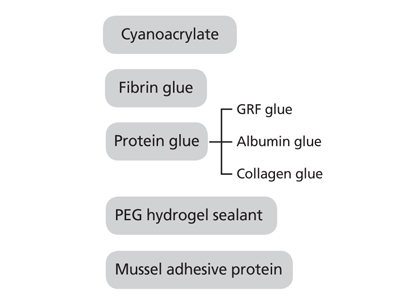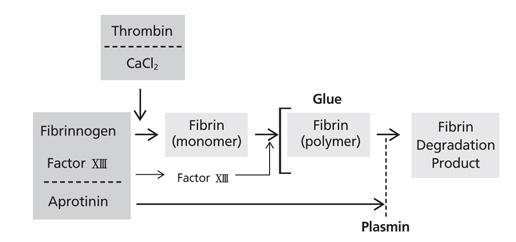J Korean Med Assoc.
2014 Jul;57(7):609-613. 10.5124/jkma.2014.57.7.609.
Surgical sealants, glues and adhesive agents in the medical market
- Affiliations
-
- 1Department of Plastic and Reconstructive Surgery, The Catholic University of Korea College of Medicine, Seoul, Korea. rhie@catholic.ac.kr
- KMID: 2194897
- DOI: http://doi.org/10.5124/jkma.2014.57.7.609
Abstract
- Suture threads have been the mainstay material for bonding biologic tissues in the medical field, and are still used as the basic method for wound closure; on the other hand, various types of medical glue have also been continuously developed as an alternative approach. Cyanoacrylate, fibrin glue, protein glue, polyethylene glycol polymer hydrogel glue, and mussel protein are currently marketed as clinical products; among these, cyanoacrylate and fibrin glue are the most widely used bonding materials. Cyanoacrylate hardens rapidly with a high bonding strength, but is vulnerable to external stress and has tissue toxicity; fibrin glue may be easily applied on wide tissue surfaces and has an excellent hemostatic effect, but has a weak bonding strength and may provide a spreading source for infectious disease through its blood components. A perfect bonding material without such disadvantages is yet to be developed, and it is important to use each product judiciously with regard to its merits and drawbacks. Many types of medical glue are being developed and marketed in more medically advanced countries, and their usage in the medical field is constantly increasing. Global markets for such medical bonding products are undergoing rapid expansion; therefore, active research and development in the relevant fields is imperative.
Keyword
MeSH Terms
Figure
Reference
-
1. Coover HW, Joyner FB, Shearer NH Jr, Wicker TH Jr. Chemistry and performance of cyanoacrylate adhesive. J Soc Plast Surg Eng. 1959; 5:413–417.2. Matsumoto T, Hardaway RM 3rd, Pani KC, Margetis PM. Aron Alpha A "Sankyo", Japanese tissue adhesive, in surgery of internal organs. Am Surg. 1968; 34:263–267.3. Millet GH. Cyanoacrylate adhesives. In : Hartshorn SR, editor. Structural adhesives: chemistry and technology. New York: Plenum Press;1986. p. 249–307.4. Michel D, Harmand MF. Fibrin seal in wound healing: effect of thrombin and [Ca2+] on human skin fibroblast growth and collagen production. J Dermatol Sci. 1990; 1:325–333.
Article5. Han DG, Ahn GD. Medical adhesive agent. Polym Sci Technol. 2000; 11:436–442.6. Saltz R, Sierra D, Feldman D, Saltz MB, Dimick A, Vasconez LO. Experimental and clinical applications of fibrin glue. Plast Reconstr Surg. 1991; 88:1005–1015.
Article7. MedMarket Diligence. Worldwide market for surgical sealants, glues, wound closure and anti-adhesion, 2012-2017 [Internet]. Foothill Ranch: MedMarket Diligence;2012. cited 2014 Jun 16. Available from: http://www.mediligence.com/rpt/rpt-s190.htm.8. Mittermayr R, Wassermann E, Thurnher M, Simunek M, Redl H. Skin graft fixation by slow clotting fibrin sealant applied as a thin layer. Burns. 2006; 32:305–311.
Article9. Han HH, Kang IS, Mun SH. Skin graft fixation using fast-clotting fibrin glue. J Korean Wound Manage Soc. 2014; 10:14–19.10. Cha HG, Kang SG, Shin HS, Kang MS, Nam SM. Does fibrin sealant reduce seroma after immediate breast reconstruction utilizing a latissimus dorsi myocutaneous flap? Arch Plast Surg. 2012; 39:504–508.
Article11. Shin IS, Lee DW, Lew DH. Efficacy of quilting sutures and fibrin sealant together for prevention of seroma in extended latissimus dorsi flap donor sites. Arch Plast Surg. 2012; 39:509–513.
Article12. Currie LJ, Sharpe JR, Martin R. The use of fibrin glue in skin grafts and tissue-engineered skin replacements: a review. Plast Reconstr Surg. 2001; 108:1713–1726.
Article13. Guilmet D, Bachet J, Goudot B, Laurian C, Gigou F, Bical O, Barbagelatta M. Use of biological glue in acute aortic dissection: preliminary clinical results with a new surgical technique. J Thorac Cardiovasc Surg. 1979; 77:516–521.14. Kunihara T, Shiiya N, Matsuzaki K, Murashita T, Matsui Y. Recommendation for appropriate use of GRF glue in the operation for acute aortic dissection. Ann Thorac Cardiovasc Surg. 2008; 14:88–95.15. Shiono M. Surgery for acute aortic dissection using gelatin-resorcin-formalin glue: perspective from 10 years of follow-up at a single center. J Artif Organs. 2008; 11:19–23.
Article16. Jain SK, Vindal A. Gelatin-resorcin-formalin (GRF) tissue glue as a novel technique for fixing prosthetic mesh in open hernia repair. Hernia. 2009; 13:299–304.
Article17. Burkett CJ, Patel S, Tabor MH, Padhya T, Vale FL. Polyethylene glycol (PEG) hydrogel dural sealant and collagen dural graft matrix in transsphenoidal pituitary surgery for prevention of postoperative cerebrospinal fluid leaks. J Clin Neurosci. 2011; 18:1513–1517.
Article18. Than KD, Baird CJ, Olivi A. Polyethylene glycol hydrogel dural sealant may reduce incisional cerebrospinal fluid leak after posterior fossa surgery. Neurosurgery. 2008; 63:1 Suppl 1. ONS182–ONS186.
Article
- Full Text Links
- Actions
-
Cited
- CITED
-
- Close
- Share
- Similar articles
-
- Fibrin sealants in maxillofacial surgery: a introductory report
- The Effect of Three Surface Sealants on Microleakage of Class V Composite Resin Restorations
- The effect of adhesive thickness on microtensile bond strength to the cavity wall
- Evaluation of Microtensile Bond Strength of Sealant Depending on the Duration of Etching and the Use of Bonding Agent
- Use biologic fibrin adhesive in otologic surgery: compared with ammonium sulfate fibrin adhesive and tissell®



